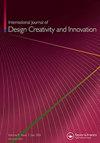How can pictorial representations stimulate the imaginative capacity of experienced multimedia designers?
IF 2.5
Q4 ENGINEERING, MANUFACTURING
International Journal of Design Creativity and Innovation
Pub Date : 2019-07-03
DOI:10.1080/21650349.2018.1465477
引用次数: 3
Abstract
Abstract Designers value imaginative capacity and consider it the basis for cultivating creative ideas, but research on designer imagination is scant. Prior research has indicated that pictorial representations stimulate designers to imagine how their designs look or feel when they are used. Therefore, the present study explored the types of pictorial representation that stimulate the imaginative capacity of experienced multimedia designers as well as how this is achieved. This study conducted a series of in-depth interviews focusing on 10 indicators of imaginative capacity with 20 experienced multimedia designers. The results indicate that each indicator of imaginative capacity can be stimulated by various types or combinations of pictorial representation. How these stimulations occur largely depends on design problems and needs. The potential changes in design resulting from referring to pictorial representations were considered on the basis of five facets: optimal combination, presentation intentions, user experience, client needs, and resource availability. Resource availability was identified as a key determinant of final decisions made by experienced designers.图片如何激发有经验的多媒体设计师的想象力?
设计师重视想象力,认为想象力是培养创意的基础,但对设计师想象力的研究却很少。先前的研究表明,图形表示刺激设计师想象他们的设计在使用时的外观或感觉。因此,本研究探讨了能激发有经验的多媒体设计师想象力的图像表现类型,以及如何实现这一目标。本研究对20位经验丰富的多媒体设计师进行了一系列深度访谈,主要围绕想象力的10个指标展开。结果表明,想象能力的每一个指标都可以通过各种类型或组合的图像表征来刺激。这些刺激如何发生在很大程度上取决于设计问题和需求。从五个方面考虑了由于引用图形表示而导致的设计的潜在变化:最佳组合、表示意图、用户体验、客户需求和资源可用性。资源可用性被认为是经验丰富的设计师做出最终决策的关键决定因素。
本文章由计算机程序翻译,如有差异,请以英文原文为准。
求助全文
约1分钟内获得全文
求助全文
来源期刊

International Journal of Design Creativity and Innovation
ENGINEERING, MANUFACTURING-
CiteScore
3.80
自引率
27.80%
发文量
15
期刊介绍:
The International Journal of Design Creativity and Innovation is an international publication that provides a forum for discussing the nature and potential of creativity and innovation in design from both theoretical and practical perspectives. Design creativity and innovation is truly an interdisciplinary academic research field that will interest and stimulate researchers of engineering design, industrial design, architecture, art, and similar areas. The journal aims to not only promote existing research disciplines but also pioneer a new one that lies in the intermediate area between the domains of systems engineering, information technology, computer science, social science, artificial intelligence, cognitive science, psychology, philosophy, linguistics, and related fields. The journal covers, but is not restricted to, the following topics: ·Theories on Design Creativity and Innovation ·Cognition of Design Creativity ·Innovative Process ·Inventive Process ·Analogical Reasoning for Design Creativity and Innovation ·Design Synthesis ·Method and Tools for Design Creativity and Innovation ·Representation of Design Creativity and Innovation ·Education for Design Creativity and Innovation ·Concept Generation and Inspiration.
 求助内容:
求助内容: 应助结果提醒方式:
应助结果提醒方式:


